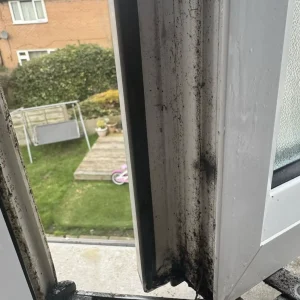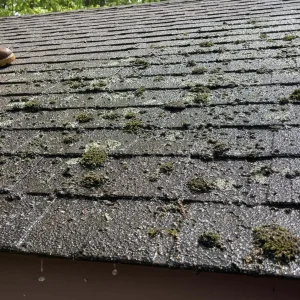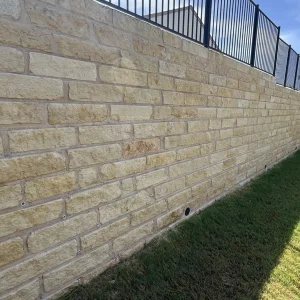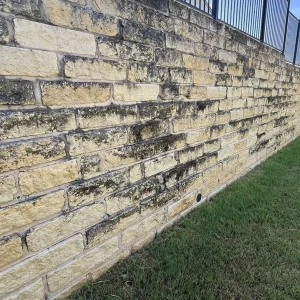This Dirt and Mould Removal guide covers everything from what causes the mess to how to spot it early and which cleaning methods actually get the job done, without damaging your walls. Those pesky patches on your wall or that green grime on your driveway? That’s not just dirt having a party – it’s mould moving in for the long haul.
Gophers You Can’t See
Ever noticed sudden musty smells, damp patches or black staining on your ceiling? You’re hosting an unwelcome guest called mould. And it doesn’t come alone. It brings mould spores, potential health risks and permanent surface damage.
Mould loves:
- Moisture from water leaks, roof and plumbing leaks or high humidity levels
- Organic material to feed on (think timber, drywall, dust, bathroom ware)
- Poor air circulation, blocked ventilation holes and brick vents
We’ve seen it all: rising damp in Victorian terraces, damp course failures and condensation in rental bathrooms without exhaust fans. Mould doesn’t discriminate – but it does love a dark, damp corner.
Spot It Before It Spreads: Early Warning Signs
Don’t wait until you’re scrubbing furry spots off your ceiling. Catching dirt and mould early can save you a fortune in repairs. Look for:
- Discolouration or black staining (especially in corners, around window frames and behind furniture)
- Peeling paint or bubbling walls
- Persistent damp smells or chloramine fumes
- Watermarks from water leaking around rooflines or air conditioners
- Health symptoms like sneezing, itchy eyes or headaches indoors
Pro tip? Grab a moisture meter if you’re unsure. If the readings are high, chances are that mould growth is already hiding beneath the surface type.
Matching the Method to the Material
Different surfaces need different tools. Treating your timber cladding the same as your concrete path? Recipe for disaster. Here’s how we clean smart, not rough:
Painted Walls & Ceilings
- Don’t pressure wash — it will strip paint and push mould deeper
- Use a neutral household detergent or mould removers
- Follow up with anti-mould paint
Brick & Masonry
- Pre-wet the surface to prevent chemical absorption
- Apply fungicides with eco-friendly ingredients
- Soft wash to remove biological growth without damaging the mortar
Rendered Surfaces
- Always low pressure (soft wash or brush)
- Eco-friendly gel cleaners or bio-clean gel to stick to vertical surfaces
- Rinse with a garden hose to avoid streaks
Timber Decking
- Garden hose and soft-bristled brush
- Tea tree oil or clove oil solutions
- No bleach — it damages wood fibres
Concrete Paths & Driveways
- Pressure wash with a surface cleaner head
- Spot treat algae or Black Mould with diluted white vinegar or bio-clean gel
| Surface Type | Best Treatment Method | Avoid This |
|---|---|---|
| Render | Soft wash + gel cleaner | High-pressure blasting |
| Timber decking | Gentle scrubbing + natural oils | Bleach, pressure washers |
| Painted walls | Mild detergent + anti-mould coat | Pressure washing, harsh chemicals |
| Brickwork | Soft wash + fungicide | Dry scrubbing, strong acids |
| Concrete driveways | Pressure clean + spot treat | Wire brushing, excessive bleach use |
Why Soft Washing Beats Blasting
We get it — there’s something satisfying about blasting a path clean with a pressure washer. But not everything can take the hit. Soft washing uses low-pressure water combined with biodegradable cleaning solutions to break down dirt and mould without damaging the surface underneath.
Ideal for:
- Coloured or painted render
- Older homes with porous bricks
- Roof tiles, solar panels, and especially terracotta
- Timber weatherboards
One time in the Blue Mountains, we saw a freshly painted facade stripped raw by a well-meaning DIY store job. High-pressure was used where soft wash would’ve done the trick — no second chances on that one.
How We Handle the Tough Stuff
When you’ve got six years of lichen growing on a tin roof or Black Mould embedded in bathroom grout, soft washing alone won’t cut it. We bring in the heavy hitters:
- Biodegradable fungicides that don’t harm stormwater drains
- Long-handled brushes for grotty corners
- HEPA (high efficiency particulate air) vacuums for interior spores
- Personal protective equipment and protective clothing for serious contamination jobs
Sometimes the job also calls for identifying the source — roof leaks, blocked ventilation holes or subfloor ventilation issues. Treat the cause, not just the stain.
Timing Your Clean Around the Weather
Planning a deep clean in the middle of the wet season? You’re wasting your time. Ideal cleaning days are:
- Dry and mild (not too hot, not too humid)
- With at least 24 hours of clear weather following
- Outside pollen season, if you’re sealing surfaces
Also, consider using exhaust fans or dehumidifiers inside to manage internal humidity levels year-round.
We also avoid jobs when the temperature is over 35°C. Not just because it’s hot as hell, but because cleaning solutions evaporate too fast to be effective.
Natural Options That Work
No greenwashing here. These eco-friendly mould treatments we use on site actually work — and won’t nuke your garden in the process:
- Clove oil: A little goes a long way — great for ceilings and painted walls
- Tea tree oil: Strong antifungal, best for timber and air conditioner filters
- White vinegar: Cheap and effective — use it neat on tiles and grout
- Bicarb soda: Gentle scrubbing agent, great for kitchen surfaces and clothes washing
We also use Rapid Application sprayers for applying eco-friendly solution blends evenly and efficiently.
Why DIY Sprays Just Don’t Cut It
Bleach and white vinegar might feel satisfying, but they’re like slapping a Band-Aid on a busted pipe. Bleach may whiten the surface temporarily, but it doesn’t kill the roots of mould. Vinegar is mildly antifungal, but it’s not enough for porous surfaces like unsealed concrete or render.
Here’s what we’ve seen in the field:
- Homeowners spray bleach, then wonder why the stains are back a month later.
- A white vinegar mix works on bathroom ware and window frames but leaves the render looking blotchy.
- Some “eco” sprays from your local DIY store are just overpriced eucalyptus or tea tree oil in a fancy bottle.
DIY can be fine for surface-level stuff, especially with microfibre cloths or natural cleaners, but for deep cleaning or prepping for anti-mould paint? You’ll want pro gear and proper mould removers.
What It Should Cost (And What to Watch Out For)
Prices vary depending on the job size, severity and accessibility. But here’s a rough idea:
- Small balcony clean: $150–$300
- Single-storey house soft wash: $500–$900
- Roof cleaning (including solar panels): $600–$1500 (higher for multi-storey)
- Mould remediation inside: $400+
Avoid quotes that are too cheap. It often means they’re not insured, using dodgy chemicals or skipping vital prep steps. You want:
- Licensed, insured crews
- Transparent scope and inclusions
- Options for eco-friendly solutions
- Clear info on delivery times and when equipment is dispatched from the supplier
- A proper money-back guarantee if things go south
Aftercare Tips for a Dry, Healthy Home
Cleaning’s just step one. Stop mould from crashing the party again with these simple habits:
- Install exhaust fans in bathrooms, laundries and above evaporative air coolers
- Fix water leaks and plumbing issues ASAP
- Clean your gutters — blockages cause overflow and wall dampness
- Improve airflow with security and insect screens, vents and open windows
- Use a dehumidifier if indoor humidity levels are high
Got brick vents or weep holes near the subfloor? Make sure they’re not blocked. That air circulation helps prevent rising damp and long-term mould problems.
Don’t Let the Green Stuff Win
Dirt and mould removal isn’t just about curb appeal — it’s about safety, environmental health and keeping costly problems at bay. Whether you do it yourself with gloves and a microfibre cloth or call a crew with a Rapid Application soft wash rig, always think long term.
Got a stubborn stain or recurring mould patch? Whether it’s exterior grime or indoor spores, our Window Cleaning Melbourne Crew is also ready to help you tackle the toughest jobs with clarity and care. Give us a shout. We’ve cleaned everything from sandstone courtyards to air conditioner ducts and bathroom ceilings full of furry invaders. It’s what we do — and we’ll make sure it doesn’t come back anytime soon.
Why Choose Us

Your satisfaction is our top priority. We tailor our services to meet your specific needs

We are committed to environmental responsibility. Our cleaning products are eco-friendly.

Pricing
We offer competitive pricing without compromising on the quality of our services.

Expertise
As a locally owned and operated company, we understand the unique needs of our community.
FAQ
Can I use bleach to kill mould on walls?
Bleach only lightens the stain — it doesn’t kill the root spores, for walls use white vinegar, tea tree oil or clove oil.
How often should I get my exterior cleaned?
Every 12-18 months is a good rhythm, depending on surface type, climate and presence of ventilation holes. Shaded homes may need more frequent cleans.
Is mould dangerous to my health?
Some types, like Black Mould, can trigger respiratory issues and impact environmental health, especially for kids and asthma sufferers.
Do I need a specialist for indoor mould?
Yes. A mould specialist can find hidden leaks, structural issues and treat mould with professional equipment like HEPA vacuums and protective clothing.
Can pressure damage my render or paint?
Absolutely. We only use soft washing or natural cleaners like Bio-Clean gel and liquid detergent on delicate surfaces.





